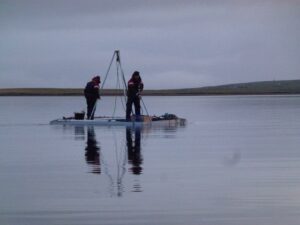
I have been spending the past week working with my colleagues on the Rising Tide team. We should be out doing fieldwork, but what we are actually doing is listening to the wind and the rain and using enforced time indoors to work on some publications.
We have been focussing on three areas in our project to reconstruct the past landscape of Orkney and the way in which it has changed through time: the Loch of Stenness; the Bay of Firth and the island of Sanday. Work in the Loch of Stenness has reached a good point to publish, work in Sanday is still progressing, and we just needed a couple of sediment cores from the Bay of Firth. We have a small boat and a raft which we use to extract the cores from the seabed and we can then analyse the contents of the mud and investigate data on all sorts of interesting things like the incursion of marine water into the area and the resultant changes in microfauna and general conditions. Rising sea-level since the end of the last Ice Age means that the islands have been gradually getting smaller and I am interested in the impact this has had on the population. Luckily that rise in sea-level has slowed down considerably just now.
We often work at this time, the waters are clearer (if cold) so you can see what you are doing, and it is a good time for us all to get together (later in the year people tend to be working in more exotic locations). Sometimes the weather is great. Not so this year. We seem to have been at the centre of a storm for at least a week. As our boat and raft are small we hired a local survey boat to venture out on one of the calmer days but even then it was not possible to hold it still enough for coring. So writing it is.
Actually, this is not as bad as it seems. We want to publish our work and being shut away with nothing to do but write is a rare privilege. It is also useful to spend the week together in a sort of hothouse of ideas. I’ll let you know when we achieve those hard fought publications.
Meanwhile, it does make me think of our prehistoric forebears in Orkney. Mesolithic families knew the terrain and could hunker down somewhere reasonably sheltered where food (shoreline resources?) would be accessible for least effort. They’d still need fuel to keep warm, and other resources such as fresh water. And the longer they were in one place, the further afield they’d need to venture to collect those. So it can’t have been fun. I think it would have been worse in the Neolithic, though. One hopes they stockpiled plenty of fuel and food for the winter, and kept their houses in good nick, but there would still be basic farming tasks to complete. The animals would need tending. A long storm would require stamina and skill, and perhaps luck, to survive. Living in a larger, more permanent community had advantages and disadvantages.
I know that I am very soft compared to my ancestors; my needs are far greater than they could ever have imagined. Times like this fill me with respect for their skills and abilities.
On a brighter note – we had a great display of the aurora (known here as the Merry Dancers) on New Years Eve. I know that is chance timing and that the days of significance would have been different in the prehistoric past, but things like that fill me with wonder and make me feel part of some greater whole.
You must be logged in to post a comment.